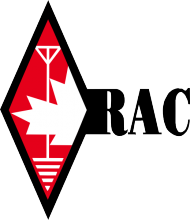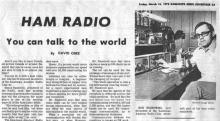Main menu
You are here
KARC History: Early VHF Radio in Kamloops, by Ken Hoshowski, VE7FP
This made for a surplus of the old boat anchors which were easily adapted for ham radio use, typically single channel, crystal controlled, and usually on 147.330 MHz. This is what I was still using when I moved back to Kamloops in 1970.
I got involved in the local club and was President in 1971 and 1972. The BCFM Society in Vancouver had access to surplus repeaters. I was in contact with Dave Powell Williams who, as well as a ham, was a pilot and flew a repeater to Kamloops. This was a donation and no cost to the KARC. At that time Colin Gowans, VE7BNM was our most knowledgeable technician who undertook the installation of the repeater on Dufferin Mountain. I had previously done all the necessary paperwork with Transport Canada regarding licensing the repeater. CFJC TV had a small shack on the site and graciously consented to give us space and power. I can’t remember who arranged a telephone pole for our antenna installation but it was big and long enough that we had to get a small crane truck to lift it into the hole. We had to rent a jack hammer to dig the hole in the very rocky ground. Once the pole was installed we had to attach the separate receive and transmit antennas. Peter Stonier, VE7CBN, and I installed the antennas on a cold wet day. A duplexer was way out of our means. The antennas were installed one above the other with a spacing of about 10 feet. I recall bolting the upper antenna in place on a wet and windy day. Our extension ladder was only 20 feet and trying to hold and bolt the antenna in place required both hands. I had to tie a rope around my waist and around the pole to hold me while I attached the antenna. In the meanwhile it was pouring rain which ran down the pole and into my trousers and I am sure out my pant legs. I have never been so cold in my life. It took me about 15 minutes to dry out and warm up with the car heater on full. It was about this time that Inoue (later to become Icom) came out with the IC2F VHF 2 meter crystal controlled transceiver. It had 10 watts out and 6 channels. We thought, who would ever need 6 channels? Our repeater operated on 146.34-146.94 and 147.33 and 146.52 remained as popular simplex frequencies. In 1973 I purchased a Kenwood Handy Transceiver which was what we would call today a “handheld”. It was battery powered, 1 watt output and about 10 times bigger in size than today’s handheld radios! I still have both the IC2F and the Kenwood although they both should probably be in a museum. Our club remained active and it was decided that Greenstone Mountain would be a good site for a new repeater. I recall a bunch of us checking out the site in the early spring when we still needed snowshoes to get to the BC Forest lookout. In early 1975 I again did the application for a repeater installation on Greenstone Mountain. In May of 1975 my family moved to Salmon Arm where we initiated the formation of the Shuswap Amateur Radio Club.The Kamloops Amateur Radio Club has much to be proud of in its accomplishments since the early days of VHF radio and many thanks to those who kept up the equipment and continued the club's operation.
We moved back to Kamloops in 2007 but have been relatively inactive. After 54 years of having a ham license I decided to get back into the fold and have officially rejoined the Kamloops Amateur Radio Club. After building my own radios in the 1960's (mostly tube type) I am so far out of touch with all the new technology that I have to get my grandkids to program my cell phone. I look forward to getting involved again (and we look forward to more club history articles, Ken! -- Ed.)







